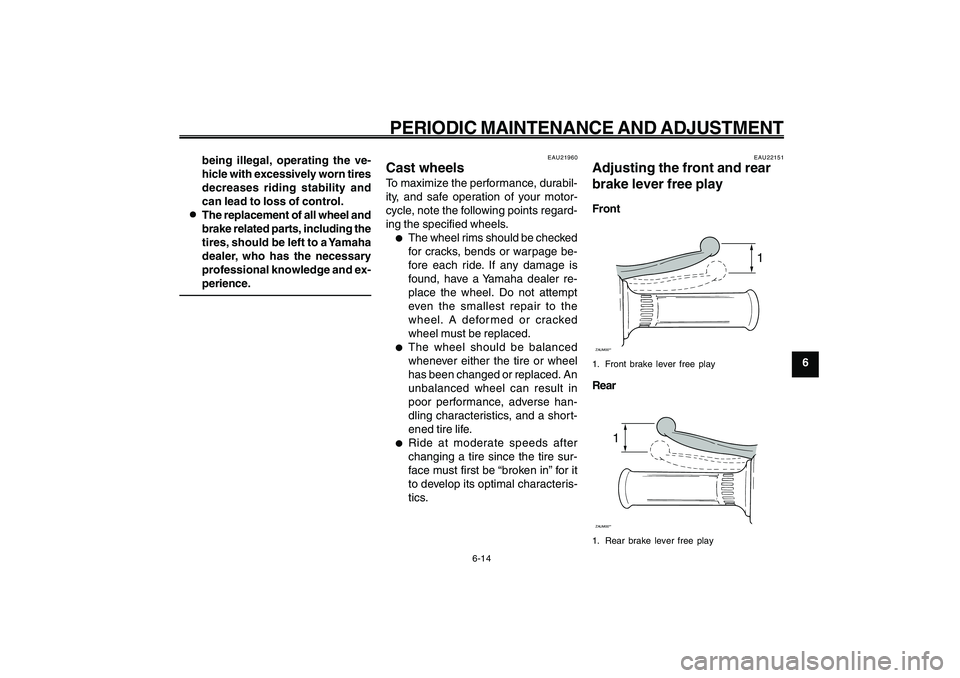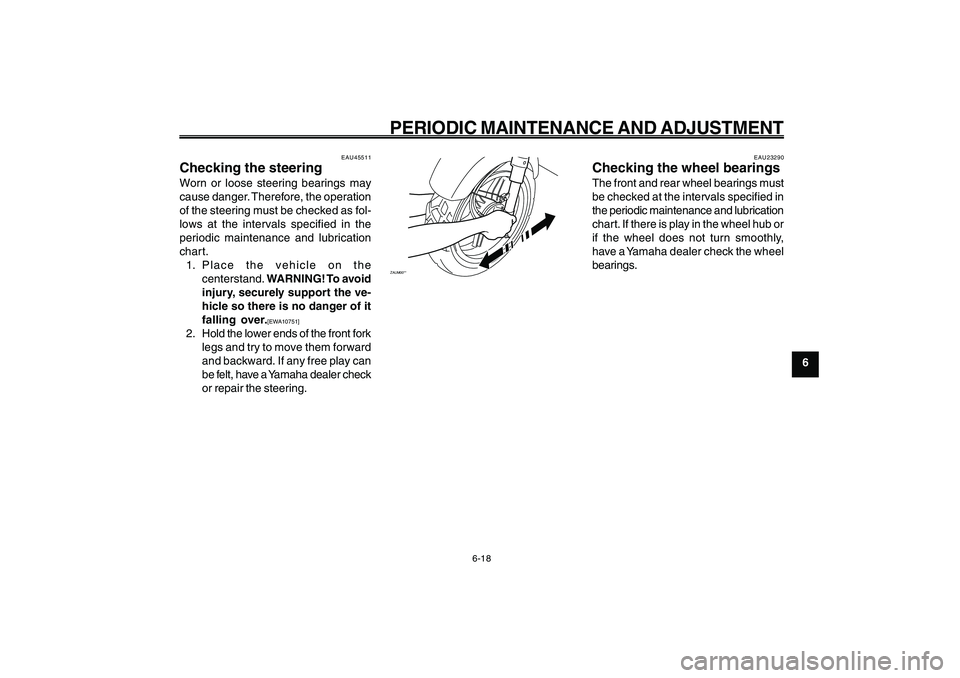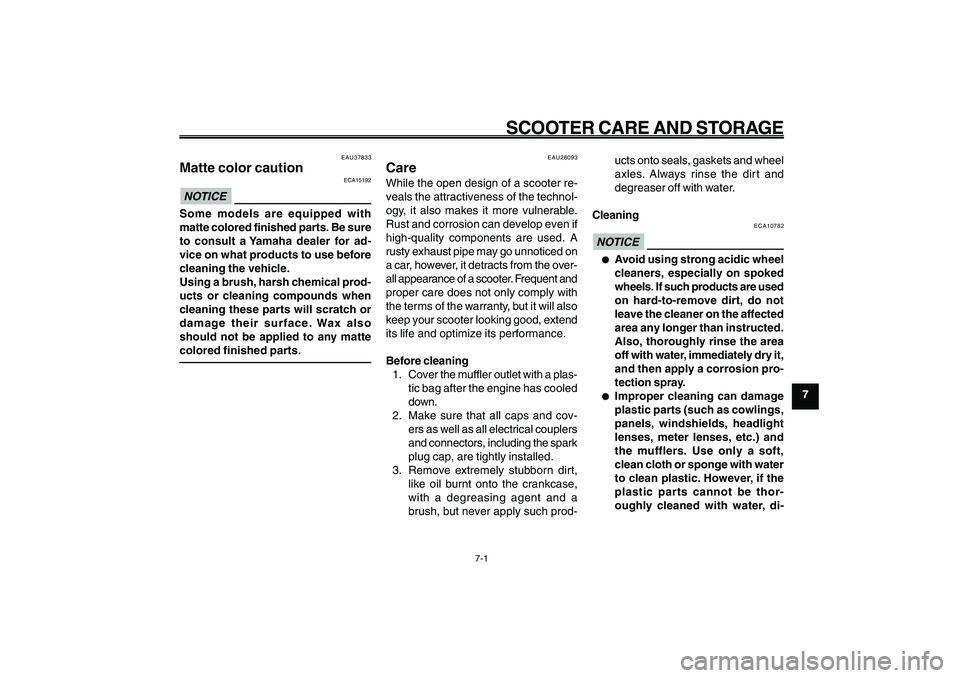2009 YAMAHA GIGGLE50 wheel
[x] Cancel search: wheelPage 6 of 74

1
2
3
4
5
6
7
8
9
EAU10210
TABLE OF CONTENTSSAFETY INFORMATION .................... 1-1
Further safe-riding points ................ 1-5
DESCRIPTION ................................... 2-1
Left view .......................................... 2-1
Right view ........................................ 2-2
Controls and instruments ................ 2-3
INSTRUMENT AND CONTROL FUNC-
TIONS................................................. 3-1
Main switch/steering lock ................ 3-1
Keyhole cover ................................. 3-2
Indicator and warning lights ............ 3-3
Speedometer unit............................ 3-4
Fuel gauge ...................................... 3-5
Handlebar switches........................ 3-5
Front brake lever ............................. 3-6
Rear brake lever ............................. 3-7
Fuel tank cap ................................... 3-7
Fuel................................................. 3-8
Catalytic converters ......................... 3-9
Kickstarter......................................3-10
Seat...............................................3-10
Helmet holder................................3-10
Storage compartment ....................3-11
Luggage hook...............................3-12
FOR YOUR SAFETY - PRE-OPERATION
CHECKS............................................ 4-1
Pre-operation check list .................. 4-2OPERATION AND IMPORTANT RIDING
POINTS............................................... 5-1
Starting the engine .......................... 5-1
Starting off ....................................... 5-2
Acceleration and deceleration........ 5-2
Braking............................................ 5-2
Tips for reducing fuel consumption . 5-3
Engine break-in............................... 5-3
Parking............................................ 5-4
PERIODIC MAINTENANCE AND
ADJUSTMENT................................... 6-1
Periodic maintenance and lubrication
chart............................................. 6-2
Removing and installing panels ..... 6-5
Checking the spark plug ................. 6-6
Engine oil........................................ 6-7
Final transmission oil ...................... 6-9
Coolant..........................................6-10
Replacing the air filter element .....6-11
Checking the throttle cable free
play............................................6-12
Valve clearance.............................6-12
Tires...............................................6-12
Cast wheels ...................................6-14
Adjusting the front and rear brake lever
free play .....................................6-14
Checking the front and rear brake
shoes.........................................6-15Checking and lubricating the throttle
grip and cable ............................6-16
Lubricating the front and rear brake
levers.........................................6-16
Checking and lubricating the
centerstand................................6-17
Checking the front fork ..................6-17
Checking the steering ...................6-18
Checking the wheel bearings .......6-18
Battery ...........................................6-19
Replacing the fuse ........................6-20
Replacing the headlight bulb ........6-21
Replacing the tail/brake light
bulb............................................6-22
Replacing a turn signal light
bulb............................................6-22
Troubleshooting............................6-23
Troubleshooting charts.................6-24
SCOOTER CARE AND STORAGE .... 7-1
Matte color caution .......................... 7-1
Care................................................. 7-1
Storage............................................ 7-4
SPECIFICATIONS.............................. 8-1
CONSUMER INFORMATION ............. 9-1
Identification numbers..................... 9-1
Page 9 of 74

1-9
EAU10221
Q QQ Q
Q
SAFETY INFORMATION
1
2
3
4
5
6
7
8
9
1-2
typical error made by the operator
is veering wide on a turn due to
excessive speed or undercornering
(insufficient lean angle for the
speed).
Always obey the speed limit
and never travel faster than
warranted by road and traffic
conditions.
Always signal before turning or
changing lanes. Make sure that
other motorists can see you.
●
The posture of the operator and
passenger is important for proper
control.
The operator should keep both
hands on the handlebar and
both feet on the operator
footrests during operation to
maintain control of the scooter.
The passenger should always
hold onto the operator, the seat
strap or grab bar, if equipped,
with both hands and keep both
feet on the passenger footrests.
Never carry a passenger unlesshe or she can firmly place both
feet on the passenger foot-
rests.
●
Never ride under the influence of
alcohol or other drugs.
●
This scooter is designed for on-road
use only. It is not suitable for off-
road use.
Protective apparel
The majority of fatalities from scooter
accidents are the result of head injuries.
The use of a safety helmet is the single
most critical factor in the prevention or
reduction of head injuries.
●
Always wear an approved helmet.
●
Wear a face shield or goggles. Wind
in your unprotected eyes could con-
tribute to an impairment of vision
that could delay seeing a hazard.
●
The use of a jacket, substantial
shoes, trousers, gloves, etc., is
effective in preventing or reducing
abrasions or lacerations.
●
Never wear loose-fitting clothes,
otherwise they could catch on thecontrol levers or wheels and cause
injury or an accident.
●
Always wear protective clothing
that covers your legs, ankles, and
feet. The engine or exhaust system
become very hot during or after
operation and can cause burns.
●
A passenger should also observe
the above precautions.
Avoid Carbon Monoxide Poisoning
All engine exhaust contains carbon
monoxide, a deadly gas. Breathing car-
bon monoxide can cause headaches,
dizziness, drowsiness, nausea, confu-
sion, and eventually death.
Carbon Monoxide is a colorless, odor-
less, tasteless gas which may be
present even if you do not see or smell
any engine exhaust. Deadly levels of
carbon monoxide can collect rapidly and
you can quickly be overcome and un-
able to save yourself. Also, deadly lev-
els of carbon monoxide can linger for
hours or days in enclosed or poorly ven-
tilated areas. If you experience any
Page 30 of 74

4-30
1
2
3
4
5
6
7
8
9
EAU15582
FOR YOUR SAFETY - PRE-OPERATION CHECKS
4-2
EAU15605
Pre-operation check listPre-operation check list
ITEM CHECKS PAGE
Fuel• Check fuel level in fuel tank.
• Refuel if necessary.
• Check fuel line for leakage.3-5, 3-7
~3-8
Engine oil• Check oil level in engine.
• If necessary, add recommended oil to specified level.
• Check vehicle for oil leakage.6-7
Final transmission oil• Check vehicle for oil leakage. 6-9
Coolant• Check coolant level in reservoir
• If necessary, add recommended coolant to specified level.
• Check cooling system for leakage.6-10
Front brake• Check operation.
• Lubricate cable if necessary.
• Check lever free play.
• Adjust if necessary.6-14
~6-15
Rear brake• Check operation.
• Lubricate cable if necessary.
• Check lever free play.
• Adjust if necessary.6-14~6-15
Throttle grip• Make sure that operation is smooth.
• Check cable free play.
• If necessary, have Yamaha dealer adjust cable free play and lubricate cable and
grip housing.6-16
Wheels and tires• Check for damage.
• Check tire condition and tread depth.
• Check air pressure.
• Correct if necessary.6-12~6-14
Brake levers• Make sure that operation is smooth.
• Lubricate lever pivoting points if necessary.6-16
Page 37 of 74

6-37
1
2
3
4
5
6
7
8
9
EAU1722A
PERIODIC MAINTENANCE AND ADJUSTMENT
6-2
Periodic maintenance and lubrication chart
EAU17715
Periodic maintenance and lubrication chartTIP● ●● ●
●
The annual checks must be performed every year, except if a kilometer-based maintenance, or for the UK, a
mileage-based maintenance, is performed instead.
●
From 30000 km (17500 mi), repeat the maintenance intervals starting from 6000 km (3500 mi).
●
Items marked with an asterisk should be performed by a Yamaha dealer as they require special tools, data and technical
skills.
NO. ITEM CHECK OR MAINTENANCE JOBODOMETER READING
ANNUAL
CHECK
1000 km
(600 mi)6000 km
(3500 mi)12000 km
(7000 mi)18000 km
(10500 mi)24000 km
(14000 mi)
1
*Fuel line• Check fuel hoses and vacuum hose for cracks or
damage.�—�—�—�— �—
2 Spark plug• Check condition.
• Clean and regap.�—�—
• Replace.�—�—
3*Valves• Check and adjust valve clearance when engine is cold.�—�—�—�—
4*Air filter element• Replace.�—�—�—�— �—
5*Front brake• Check operation and adjust brake lever free play.�—�— �— �— �— �—
• Replace brake shoes. Whenever worn to the limit
6*Rear brake• Check operation and adjust brake lever free play.�—�—�—�—�— �—
• Replace brake shoes. Whenever worn to the limit
7*Wheels• Check runout and for damage.�—�—�—�—
8*Tires• Check tread depth and for damage.
• Replace if necessary.
• Check air pressure.
• Correct if necessary.�—�—�—�— �—
9*Wheel bearings• Check bearing for looseness or damage.�—�—�—�—
Page 45 of 74

6-45
1
2
3
4
5
6
7
8
9
EAU1722A
PERIODIC MAINTENANCE AND ADJUSTMENT
6-10
torque. WARNING! Make sure that
no foreign material enters the fi-
nal transmission case. Make sure
that no oil gets on the tire or
wheel.
[EWA11311]
Tightening torque:
Final transmission oil filler bolt:
Recommended final transmission oil:
See page 8-1.
Oil quantity:
0.10 L (0.11 US qt, 0.09 Imp.qt)7. Check the final transmission case
for oil leakage. If oil is leaking,
check for the cause.
EAU20070
CoolantThe coolant level should be checked
before each ride. In addition, the cool-
ant must be changed at the intervals
specified in the periodic maintenance
and lubrication chart. Coolant
EAUT1523
To check the coolant level
The coolant level should be checked as
follows before each ride. In addition, the
coolant must be changed at the inter-
vals specified in the periodic mainte-
nance and lubrication chart.
1. Place the vehicle on the
centerstand.TIP
8The coolant level must be checked
on a cold engine since the level
varies with engine temperature.
8Make sure that the vehicle is posi-
tioned straight up when checking
the coolant level. A slight tilt to the
side can result in a false reading.
2. Check the coolant level in the cool-
ant reservoir.TIP
The coolant should be between the mini-
mum and maximum level marks.ZAUM00**
12
1. Maximum level mark
2. Minimum level mark
Page 49 of 74

6-49
1
2
3
4
5
6
7
8
9
EAU1722A
PERIODIC MAINTENANCE AND ADJUSTMENT
6-14
being illegal, operating the ve-
hicle with excessively worn tires
decreases riding stability and
can lead to loss of control.
8 88 8
8The replacement of all wheel and
brake related parts, including the
tires, should be left to a Yamaha
dealer, who has the necessary
professional knowledge and ex-
perience.
EAU21960
Cast wheelsTo maximize the performance, durabil-
ity, and safe operation of your motor-
cycle, note the following points regard-
ing the specified wheels.●
The wheel rims should be checked
for cracks, bends or warpage be-
fore each ride. If any damage is
found, have a Yamaha dealer re-
place the wheel. Do not attempt
even the smallest repair to the
wheel. A deformed or cracked
wheel must be replaced.
●
The wheel should be balanced
whenever either the tire or wheel
has been changed or replaced. An
unbalanced wheel can result in
poor performance, adverse han-
dling characteristics, and a short-
ened tire life.
●
Ride at moderate speeds after
changing a tire since the tire sur-
face must first be “broken in” for it
to develop its optimal characteris-
tics. Wheels
Front and rear brake lever free play, adjusting
EAU22151
Adjusting the front and rear
brake lever free playFront
1
ZAUM00**1. Front brake lever free playRear
1
ZAUM00**1. Rear brake lever free play
Page 53 of 74

6-53
1
2
3
4
5
6
7
8
9
EAU1722A
PERIODIC MAINTENANCE AND ADJUSTMENT
6-18
Steering, checking
Wheel bearings, checking
EAU45511
Checking the steeringWorn or loose steering bearings may
cause danger. Therefore, the operation
of the steering must be checked as fol-
lows at the intervals specified in the
periodic maintenance and lubrication
chart.
1. Place the vehicle on the
centerstand. WARNING! To avoid
injury, securely support the ve-
hicle so there is no danger of it
falling over.
[EWA10751]
2. Hold the lower ends of the front fork
legs and try to move them forward
and backward. If any free play can
be felt, have a Yamaha dealer check
or repair the steering.
ZAUM00**
EAU23290
Checking the wheel bearingsThe front and rear wheel bearings must
be checked at the intervals specified in
the periodic maintenance and lubrication
chart. If there is play in the wheel hub or
if the wheel does not turn smoothly,
have a Yamaha dealer check the wheel
bearings.
Page 61 of 74

7-61
1
2
3
4
5
6
7
8
9
EAU25991
SCOOTER CARE AND STORAGE
7-1
EAU25991
SCOOTER CARE AND STORAGE
EAU37833
Matte color caution
ECA15192
NOTICESome models are equipped with
matte colored finished parts. Be sure
to consult a Yamaha dealer for ad-
vice on what products to use before
cleaning the vehicle.
Using a brush, harsh chemical prod-
ucts or cleaning compounds when
cleaning these parts will scratch or
damage their surface. Wax also
should not be applied to any matte
colored finished parts.Matte color, caution
Care
EAU26093
CareWhile the open design of a scooter re-
veals the attractiveness of the technol-
ogy, it also makes it more vulnerable.
Rust and corrosion can develop even if
high-quality components are used. A
rusty exhaust pipe may go unnoticed on
a car, however, it detracts from the over-
all appearance of a scooter. Frequent and
proper care does not only comply with
the terms of the warranty, but it will also
keep your scooter looking good, extend
its life and optimize its performance.
Before cleaning
1. Cover the muffler outlet with a plas-
tic bag after the engine has cooled
down.
2. Make sure that all caps and cov-
ers as well as all electrical couplers
and connectors, including the spark
plug cap, are tightly installed.
3. Remove extremely stubborn dirt,
like oil burnt onto the crankcase,
with a degreasing agent and a
brush, but never apply such prod-ucts onto seals, gaskets and wheel
axles. Always rinse the dirt and
degreaser off with water.
Cleaning
ECA10782
NOTICE● ●● ●
●
Avoid using strong acidic wheel
cleaners, especially on spoked
wheels. If such products are used
on hard-to-remove dirt, do not
leave the cleaner on the affected
area any longer than instructed.
Also, thoroughly rinse the area
off with water, immediately dry it,
and then apply a corrosion pro-
tection spray.
● ●● ●
●
Improper cleaning can damage
plastic parts (such as cowlings,
panels, windshields, headlight
lenses, meter lenses, etc.) and
the mufflers. Use only a soft,
clean cloth or sponge with water
to clean plastic. However, if the
plastic parts cannot be thor-
oughly cleaned with water, di-